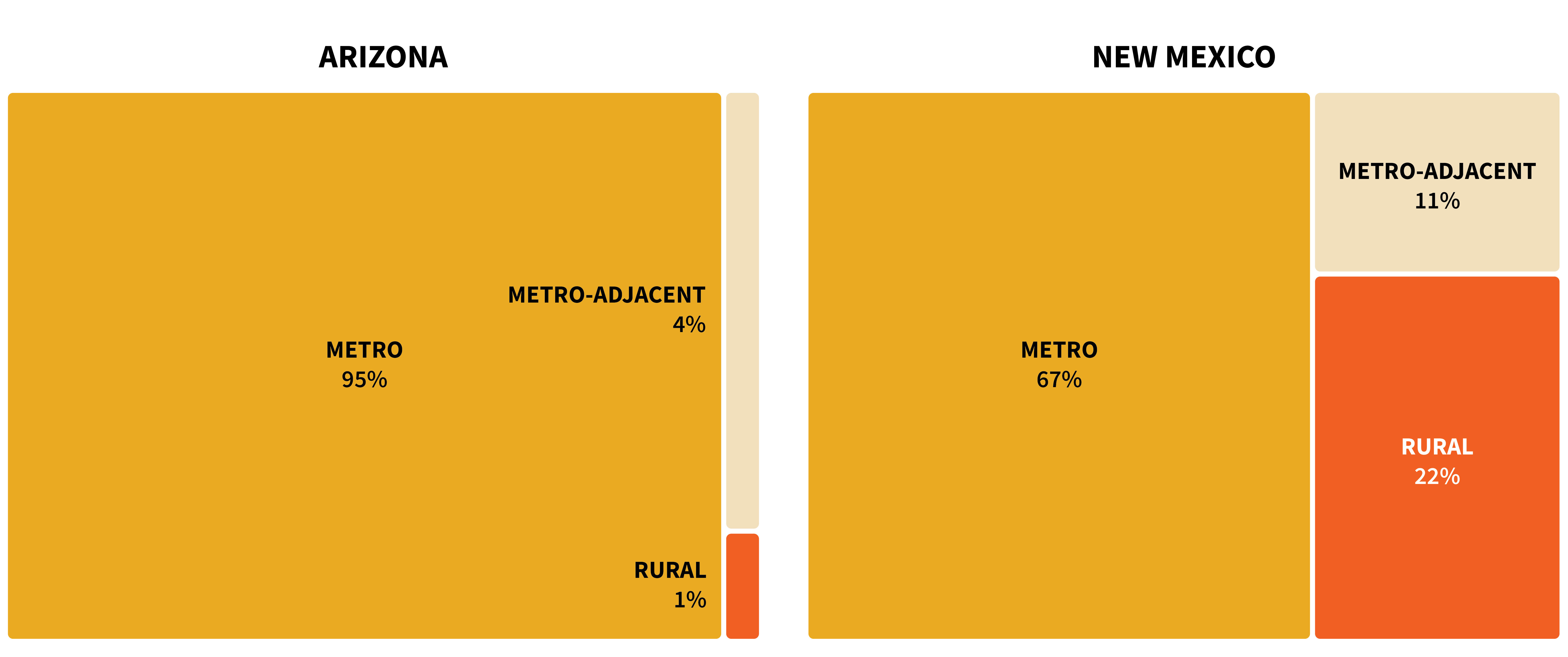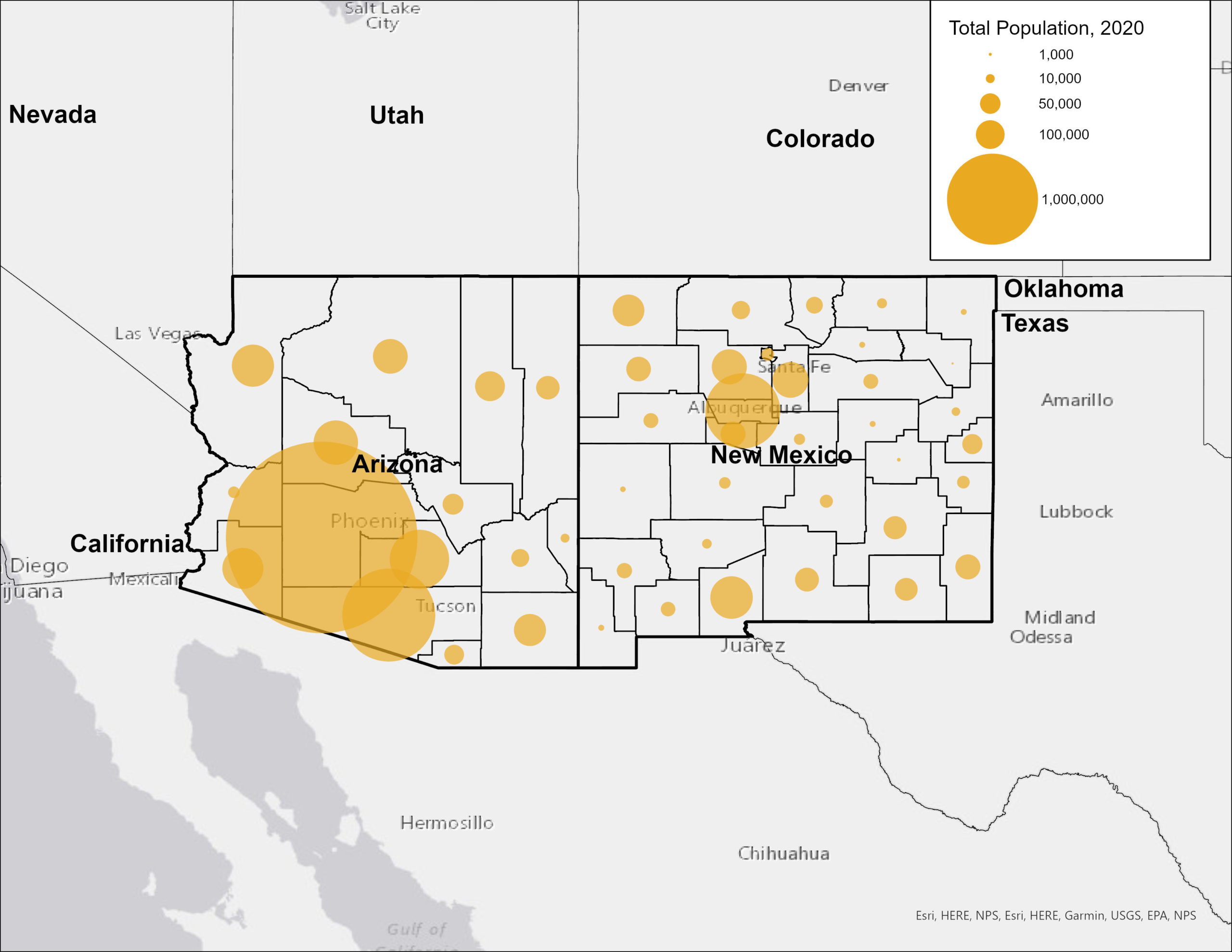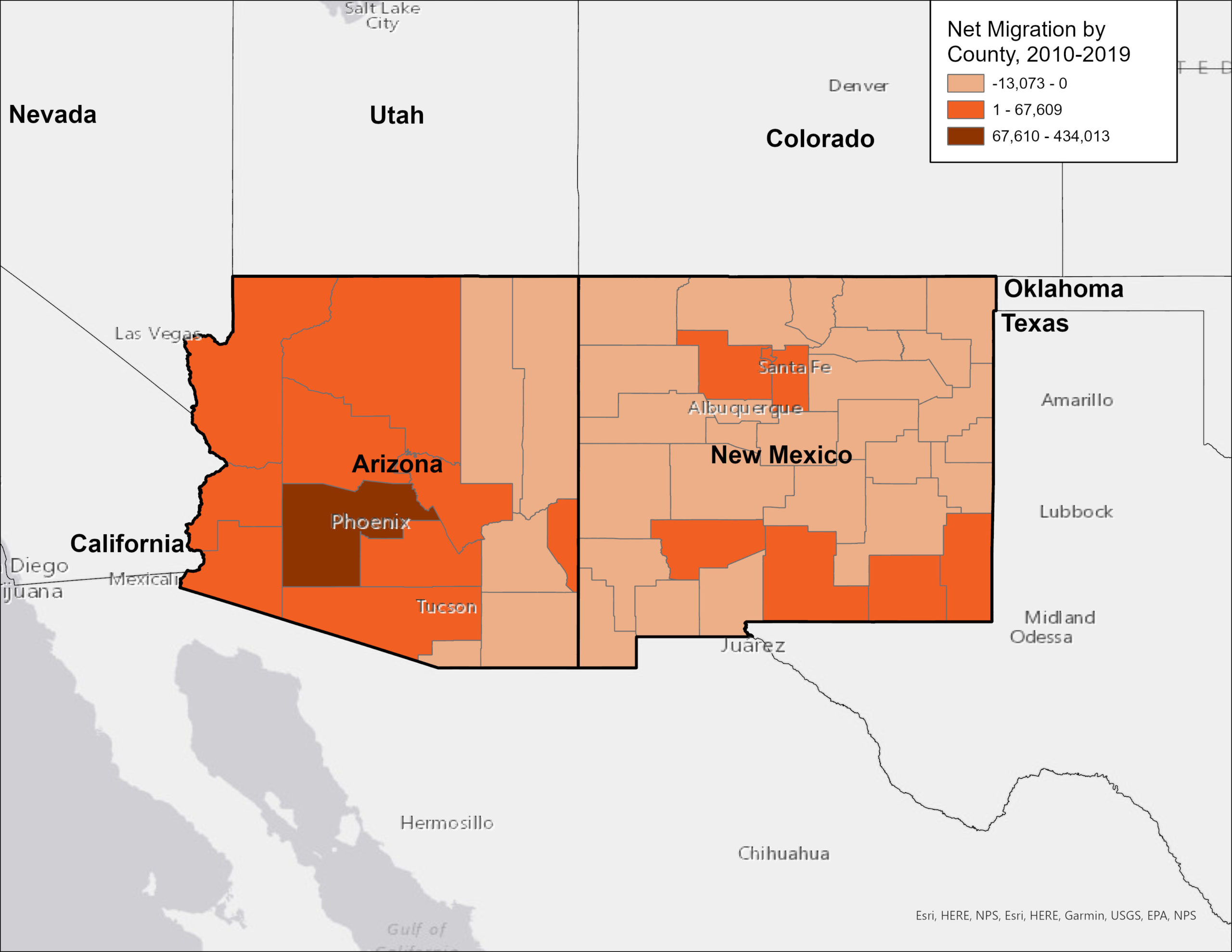Jenin Abu-Hashem
Former Research Intern

5 takeaways from population data in Arizona and New Mexico
August 17, 2023
Former Research Intern
Research Associate
Having been on the forefront of Manifest Destiny, the Gold Rush, and post-World War II urban sprawl, the Southwest has had a long history of exponential growth, innovation, and development. But is this the case across the entire region?
Here, we present a tale of two states—Arizona and New Mexico—and break down five reasons why the actual story is more nuanced than it seems.
1. Their populations are not growing at the same rate. Compared to the nation as a whole, which grew by roughly 7% over the decade, New Mexico’s population growth was below average (3%), while Arizona’s was above average (12%). This difference is not explained by fertility rates in Arizona and New Mexico. Nor is it explained by mortality rates; despite New Mexico having a higher age-adjusted mortality rate than Arizona between 2010-2020, the difference is not impactful. It boils down to migration, especially of people moving from other, often neighboring, states. Heading into 2020, Arizona had a net migration gain of almost 600,000 new residents, while New Mexico had a net loss of about 40,000 people.
2. Metropolitan counties are booming, especially in Arizona. Growth in metropolitan counties drove population gains in Arizona and New Mexico from 2010 to 2020. And while most of the population in both states resides in metropolitan counties, the share is much higher in Arizona (Figure 1). This is partly due to the more urbanized landscape of the state: More than half of Arizona’s counties are classified as metropolitan, compared to less than 1 in 5 counties in New Mexico.

Sources: U.S. Census Bureau, 2020 Census Redistricting Data (Public Law 94-171); USDA Economic Research Service, 2013 Urban Influence Codes.
In fact, more people live in Arizona’s metro counties than in the entire state of New Mexico. The two largest counties in Arizona are each home to over 1 million people, while the largest in New Mexico has under 700,000. While Bernalillo County is home to 1 in 3 New Mexico residents, Arizona’s Maricopa County has over six times as many people (Figure 2).

Source: U.S. Census Bureau, 2020 Census Redistricting Data (Public Law 94-171).
Migration into Maricopa County and surrounding counties has driven much of Arizona’s population growth. Meanwhile, most New Mexico counties saw negative net migration; 70% of the metro counties that grew experienced negative net migration, meaning the slight growth that they witnessed can largely be attributed to their birth and mortality ratios. Where New Mexico did see migration gains, the increase was likely due in part to job growth in the oil industry, which may not be sustainable over time.

Source: PRB U.S. Indicators: Net Migration (2010-19).
3. Metropolitan Arizona has an abundance of business and employment opportunities. Arizona boasts one of the fastest-growing economies in the country. Over the past half-decade, the state has consistently witnessed job, income, and sales growth above the national average, with Maricopa County experiencing significant expansions in sectors such as health care, information, construction, and accommodation and food services. Home to Phoenix and its multitude of edge cities, the county was the most populous and fastest-growing in the state from 2010 to 2020, witnessing a 16% jump in its population. New business and job growth, particularly in the tech industry, have earned the area the nickname “Silicon Desert”, reflecting its status as a prosperous, pro-business environment supportive of start-ups with a healthy job market that promotes in-migration but without the high cost of living of California’s Silicon Valley.
4. New Mexico’s rural settings and struggling economic and education sectors are pushing people to leave. While New Mexico and Arizona rank similarly on quality of life indicators comparing cost-of-living, labor, inequality, life expectancy, and education characteristics, New Mexico lags a bit behind, mostly due to shorter life expectancy and lower rates of college degree attainment. Concerns about the quality of the K-12 education system may contribute to some of New Mexico’s out-migration, as families with children may choose to relocate to neighboring states for better schools. New Mexico scored among the 10 lowest ranking states on measures of fourth and eight-grade math and reading proficiency for the entirety of the 2010 to 2020 period.
Differences in the states’ economic approaches and opportunities may also help explain the slow growth in New Mexico. While Arizona has largely focused on growing private markets and promoting entrepreneurship, New Mexico has concentrated more resources on public spending. While Arizona regularly ranked among the top 10 states for total job growth, New Mexico frequently ranked among the bottom 10 from 2010-2020. Low job growth combined with a lack of urban settings that appeal to young adults has resulted in out-migration of working-age people to surrounding states such as Arizona, Nevada, Oklahoma, and Texas in search of city life and better job opportunities.
5. The future for the states presents different challenges. While job growth and the entrepreneurial spirit in Arizona may have their appeal, the state’s population growth is perpetuating increasingly urgent concerns about water availability amidst extensive residential development. Despite the current megadrought depleting the Colorado River—the primary source of water Arizona and all the states surrounding it—development continues without slowing. And while municipalities within Arizona are turning to other sources of water, such as groundwater and reservoirs, to continue accommodating population growth, these alternatives come with their own political complications and are finite. As the population grows and the water supply dwindles, Arizona is walking the limits on growth.
Meanwhile the out-migration of working-age adults and declining population of people under the age of 18 means New Mexico’s population is aging, which raises concern for further economic and quality of life consequences. Providing accommodations for a growing older adult population (such as healthcare, caregiving services, and accessibility modifications) and coping with a shrinking workforce puts pressure on the state’s economy. But recent trends, such as the rise in remote work, could present the opportunity to retain younger workers.
